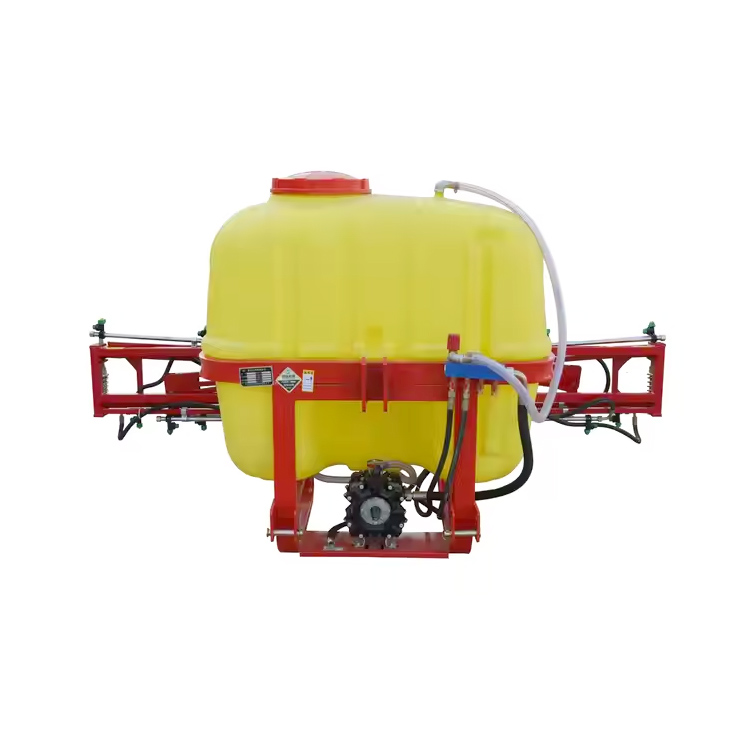What to do before using Boom Sprayer
2025-06-26
Boom sprayers are essential tools in modern agriculture, providing an efficient and precise method for applying pesticides, herbicides, fertilizers, and other chemicals. To ensure effective application, prevent damage to crops, and safeguard the environment, a thorough pre-use preparation is necessary. Here's a step-by-step guide on what to do before using a boom sprayer:
1. Inspect the Sprayer's Condition
Before operating the boom sprayer, a comprehensive inspection of the equipment is crucial. Ensure that all components are in working order, including:
Boom and Nozzles: Check for any blockages, wear, or damage. Clean nozzles to avoid uneven spraying and verify that the boom arms are functioning properly.
Sprayer Tank: Inspect the tank for any leaks or cracks. Clean the tank thoroughly if it has been used previously to avoid contamination.
Pumps and Hoses: Ensure the pump is functioning efficiently. Look for any signs of wear or leaks in hoses and connections.
Wheels and Suspension: If using a vehicle-mounted sprayer, check the wheels for proper inflation and the suspension for damage or wear.
2. Check Chemical Compatibility and Calibration
Boom sprayers are often used for applying various chemicals, so it's essential to make sure that the chemicals are compatible with the sprayer. This will help prevent damage to the sprayer or contamination of the crops. Before filling the tank, follow these steps:
Verify Chemical Compatibility: Read the labels of all chemicals you intend to use. Ensure they can be safely mixed together (if applicable) and that they are compatible with the sprayer components.
Calibrate the Sprayer: Accurate calibration is critical for ensuring that the correct amount of chemical is applied. This involves adjusting the pressure, flow rate, and nozzle settings to match the desired application rate. Use a calibration chart or follow the manufacturer's guidelines to perform this task.
3. Prepare the Right Personal Protective Equipment (PPE)
Safety is paramount when using boom sprayers, as the chemicals involved can pose health risks. Ensure that you have the appropriate PPE:
Protective Clothing: Wear long sleeves, pants, and boots to minimize skin exposure.
Gloves: Use chemical-resistant gloves to protect your hands from contact with harmful substances.
Respirators: Depending on the chemicals being applied, a respirator may be necessary to protect against inhalation of harmful fumes.
Eye Protection: Goggles or face shields should be worn to protect your eyes from splashes or spray drift.
4. Choose the Right Weather Conditions
Boom sprayers are most effective under certain weather conditions. Before using the sprayer, check the weather forecast to ensure optimal spraying conditions:
Wind Speed: Avoid spraying in high winds, as this can cause chemical drift and uneven application.
Temperature and Humidity: Ideal spraying conditions are typically early in the morning or late in the evening when temperatures are cooler. High heat can cause chemicals to evaporate too quickly, reducing effectiveness, while high humidity can cause excess runoff.
5. Prepare the Spray Solution
After ensuring that the sprayer is ready for use, it's time to prepare the chemical solution. This involves:
Measuring Chemicals Accurately: Follow the manufacturer’s instructions for the correct concentration of chemicals. Using too little may result in ineffective treatment, while using too much can harm crops or the environment.
Mixing: Always add chemicals to the tank in the correct order. Typically, liquid chemicals should be added first, followed by powders or granules. Mixing should be done slowly to avoid creating foam or clogging the sprayer.
Water Quality: Use clean water for mixing. If using hard water, consider adding water softeners to prevent chemical reactions that could affect the sprayer's performance.

6. Set the Correct Spray Pattern and Coverage
Before heading out to spray, adjust the sprayer to ensure an even and uniform application. This includes:
Setting Boom Height: Ensure the boom is at the correct height for the crop being sprayed. Too high may cause drift, while too low can cause uneven coverage.
Spray Angle and Pattern: Adjust the nozzles to achieve the desired spray pattern. Ensure that the angle of the nozzles is appropriate for the crop height and type of treatment.
Spray Volume: Ensure the correct volume of spray is being applied. Excessive spraying can lead to over-application, while insufficient spraying can lead to poor results.
7. Check for Proper Communication and Emergency Protocols
When spraying, it’s important to communicate effectively, especially when working with a team. Set up a system to ensure everyone is aware of their roles and responsibilities, and establish emergency protocols in case of chemical spills or accidents. This may include:
Emergency Contact Numbers: Keep a list of emergency contacts, including local poison control, medical facilities, and chemical manufacturers.
Spill Kits: Have a spill kit on hand to quickly contain and neutralize any chemical leaks.
First Aid Training: Ensure that you and your team are trained in basic first aid for chemical exposure, including eye rinsing, skin decontamination, and respiratory support.
8. Conduct a Test Run
Before applying the solution to the entire field, conduct a small-scale test run. This allows you to:
Check for Uniformity: Ensure that the spray pattern is even and the coverage is consistent.
Verify Equipment Settings: Test the sprayer at various speeds to ensure the pump pressure, nozzle size, and boom height are correctly adjusted.
Adjust Application Rates: Based on the test run, you can fine-tune the sprayer to achieve the desired application rate and minimize waste.
Conclusion
Proper preparation is essential for using a boom sprayer effectively and safely. By following these steps—inspecting the sprayer, ensuring chemical compatibility, calibrating the equipment, checking the weather, preparing the spray solution, and conducting a test run—you can ensure optimal performance and safeguard both your crops and the environment. This preparation will also help extend the lifespan of the sprayer and promote successful outcomes in your agricultural practices.


